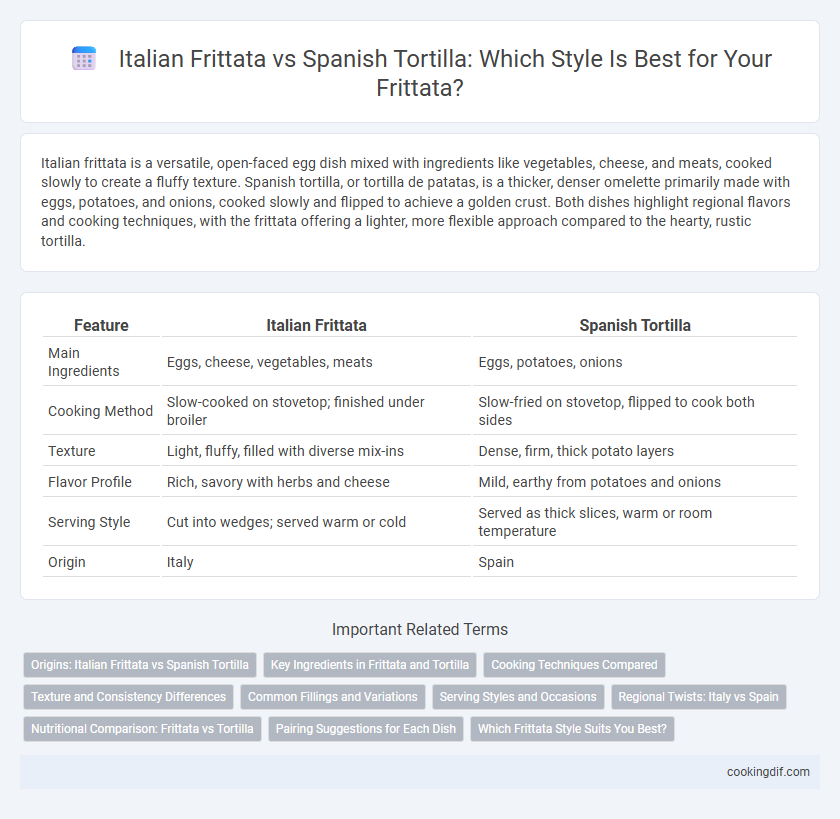Italian frittata is a versatile, open-faced egg dish mixed with ingredients like vegetables, cheese, and meats, cooked slowly to create a fluffy texture. Spanish tortilla, or tortilla de patatas, is a thicker, denser omelette primarily made with eggs, potatoes, and onions, cooked slowly and flipped to achieve a golden crust. Both dishes highlight regional flavors and cooking techniques, with the frittata offering a lighter, more flexible approach compared to the hearty, rustic tortilla.
Table of Comparison
| Feature | Italian Frittata | Spanish Tortilla |
|---|---|---|
| Main Ingredients | Eggs, cheese, vegetables, meats | Eggs, potatoes, onions |
| Cooking Method | Slow-cooked on stovetop; finished under broiler | Slow-fried on stovetop, flipped to cook both sides |
| Texture | Light, fluffy, filled with diverse mix-ins | Dense, firm, thick potato layers |
| Flavor Profile | Rich, savory with herbs and cheese | Mild, earthy from potatoes and onions |
| Serving Style | Cut into wedges; served warm or cold | Served as thick slices, warm or room temperature |
| Origin | Italy | Spain |
Origins: Italian Frittata vs Spanish Tortilla
Italian frittata originated as a versatile egg-based dish often enriched with a variety of vegetables, cheeses, and meats, reflecting regional Italian ingredients. Spanish tortilla, known as tortilla de patatas, traditionally combines eggs with potatoes and onions, emphasizing simplicity and heartiness from Spanish culinary roots. Both dishes highlight local produce and cooking techniques but differ in texture and ingredient prominence, with the frittata favoring a mixed filling and the tortilla focusing on potato as the central ingredient.
Key Ingredients in Frittata and Tortilla
Italian frittata typically features eggs combined with a variety of key ingredients such as cheeses like Parmesan or mozzarella, vegetables including spinach, tomatoes, and onions, and sometimes meats like prosciutto or sausage, all mixed and cooked slowly without flipping. In contrast, the Spanish tortilla is primarily made from eggs, thinly sliced potatoes, and onions, creating a thick, hearty omelette that is fried gently and often flipped to cook both sides evenly. Both dishes highlight eggs as the base, but the frittata embraces diverse fillings while the tortilla emphasizes simplicity and the starchy texture of potatoes.
Cooking Techniques Compared
Italian frittata is cooked slowly over low heat, allowing eggs and fillings like vegetables, cheese, and meats to set evenly without flipping, often finished under a broiler for a lightly browned top. Spanish tortilla involves cooking thick potato slices and onions in olive oil before mixing with beaten eggs, then the entire mixture is cooked slowly and flipped halfway to ensure even browning and a firm texture. Both techniques emphasize gentle heat and gradual cooking but differ in preparation: frittata incorporates diverse ingredients directly into eggs, while tortilla relies on pre-cooked potatoes as the base.
Texture and Consistency Differences
Italian frittata features a fluffy, open texture with a soft, custard-like interior achieved by slow cooking and gentle stirring, allowing eggs and fillings to blend seamlessly. In contrast, Spanish tortilla presents a denser, firmer bite with a thick, cake-like consistency formed by cooking sliced potatoes and onions within the eggs, resulting in a hearty, compact dish. The difference in preparation techniques drives the frittata's creamy smoothness versus the tortilla's robust, sliceable structure.
Common Fillings and Variations
Italian frittata commonly includes ingredients like cheeses (Parmesan, mozzarella), vegetables (spinach, zucchini, mushrooms), and cured meats (prosciutto, salami), emphasizing a rich, layered flavor. Spanish tortilla traditionally features potatoes and onions cooked in olive oil, sometimes incorporating chorizo or peppers, creating a hearty, dense texture. Variations in both dishes reflect regional produce, with frittatas often baked or finished in the oven, while tortillas are typically cooked slow on the stovetop.
Serving Styles and Occasions
Italian frittata is typically served sliced and warm or at room temperature, making it ideal for brunch, casual gatherings, or picnic meals. Spanish tortilla, thicker and heartier, is often presented as tapas in small wedges, perfect for social dining and bar snacks. Both dishes complement a variety of occasions but differ in their serving style emphasis--frittata as a versatile, shareable main dish versus tortilla as a communal appetizer.
Regional Twists: Italy vs Spain
Italian frittata features a fluffier texture achieved by mixing eggs thoroughly with ingredients like cheese, vegetables, and cured meats before cooking, often finished under a broiler for a golden top. Spanish tortilla, or tortilla de patatas, emphasizes a denser consistency with layers of thinly sliced potatoes and onions slowly cooked in olive oil, reflecting a heartier, rustic tradition. Regional twists highlight Italy's diverse, ingredient-rich approach compared to Spain's simple, staple-focused version, showcasing distinct culinary identities within similar egg-based dishes.
Nutritional Comparison: Frittata vs Tortilla
Italian frittata typically contains eggs, cheese, vegetables, and sometimes meats, resulting in a nutrient-dense dish rich in protein, healthy fats, and vitamins such as B12 and A. Spanish tortilla, made primarily with eggs, potatoes, and onions, offers a higher carbohydrate content due to the potatoes, alongside moderate protein and fat levels. Nutritionally, frittata provides more diverse vitamins and minerals, while tortilla serves as a more energy-dense option with greater carbohydrate emphasis.
Pairing Suggestions for Each Dish
Italian frittata pairs exquisitely with light, fresh ingredients such as arugula salad, cherry tomatoes, and a drizzle of balsamic glaze, highlighting its creamy texture and rich flavors. Spanish tortilla complements bold, robust sides like romesco sauce, alioli, and roasted red peppers, enhancing its hearty potato and onion base. Both dishes are elevated with regional wines: a crisp Pinot Grigio for frittata and a fruity Tempranillo for tortilla.
Which Frittata Style Suits You Best?
Italian frittata features a fluffy, open-faced omelette enriched with vegetables, cheese, and meats, offering a lighter texture ideal for quick meals or brunches. Spanish tortilla, made primarily with eggs, potatoes, and onions, delivers a denser, heartier option perfect for satisfying mains or tapas. Choose the Italian frittata for versatility and speed, while the Spanish tortilla serves best when seeking a filling, rustic dish with a robust flavor profile.
Italian frittata vs Spanish tortilla for frittata style Infographic

 cookingdif.com
cookingdif.com